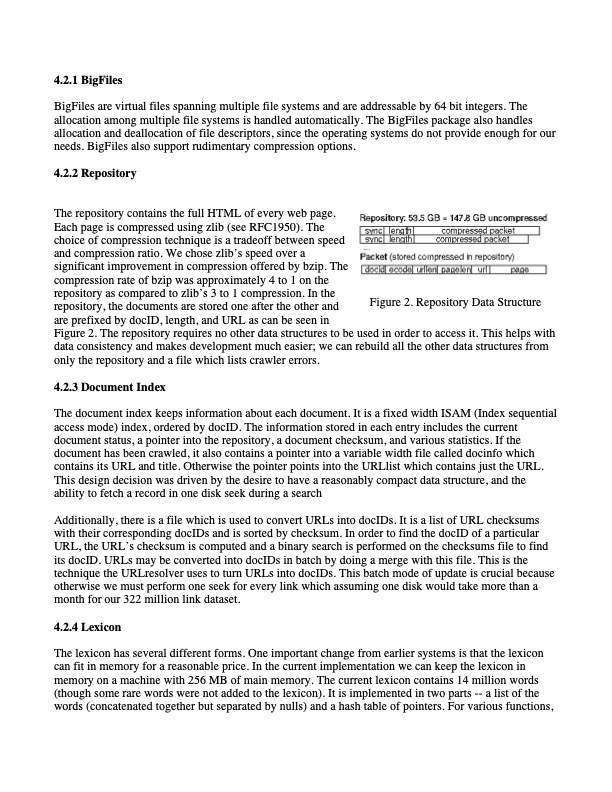
PDF Publication Title:
Text from PDF Page: 008
4.2.1 BigFiles BigFiles are virtual files spanning multiple file systems and are addressable by 64 bit integers. The allocation among multiple file systems is handled automatically. The BigFiles package also handles allocation and deallocation of file descriptors, since the operating systems do not provide enough for our needs. BigFiles also support rudimentary compression options. 4.2.2 Repository The repository contains the full HTML of every web page. Each page is compressed using zlib (see RFC1950). The choice of compression technique is a tradeoff between speed and compression ratio. We chose zlib’s speed over a significant improvement in compression offered by bzip. The compression rate of bzip was approximately 4 to 1 on the repository as compared to zlib’s 3 to 1 compression. In the repository, the documents are stored one after the other and are prefixed by docID, length, and URL as can be seen in Figure 2. The repository requires no other data structures to be used in order to access it. This helps with data consistency and makes development much easier; we can rebuild all the other data structures from only the repository and a file which lists crawler errors. 4.2.3 Document Index The document index keeps information about each document. It is a fixed width ISAM (Index sequential access mode) index, ordered by docID. The information stored in each entry includes the current document status, a pointer into the repository, a document checksum, and various statistics. If the document has been crawled, it also contains a pointer into a variable width file called docinfo which contains its URL and title. Otherwise the pointer points into the URLlist which contains just the URL. This design decision was driven by the desire to have a reasonably compact data structure, and the ability to fetch a record in one disk seek during a search Additionally, there is a file which is used to convert URLs into docIDs. It is a list of URL checksums with their corresponding docIDs and is sorted by checksum. In order to find the docID of a particular URL, the URL’s checksum is computed and a binary search is performed on the checksums file to find its docID. URLs may be converted into docIDs in batch by doing a merge with this file. This is the technique the URLresolver uses to turn URLs into docIDs. This batch mode of update is crucial because otherwise we must perform one seek for every link which assuming one disk would take more than a month for our 322 million link dataset. 4.2.4 Lexicon The lexicon has several different forms. One important change from earlier systems is that the lexicon can fit in memory for a reasonable price. In the current implementation we can keep the lexicon in memory on a machine with 256 MB of main memory. The current lexicon contains 14 million words (though some rare words were not added to the lexicon). It is implemented in two parts -- a list of the words (concatenated together but separated by nulls) and a hash table of pointers. For various functions, Figure 2. Repository Data StructurePDF Image | natomy of a Large-Scale Hypertextual Web Search Engine

PDF Search Title:
natomy of a Large-Scale Hypertextual Web Search EngineOriginal File Name Searched:
google-anatomy-of-a-search-engine.pdfDIY PDF Search: Google It | Yahoo | Bing
Cruise Ship Reviews | Luxury Resort | Jet | Yacht | and Travel Tech More Info
Cruising Review Topics and Articles More Info
Software based on Filemaker for the travel industry More Info
The Burgenstock Resort: Reviews on CruisingReview website... More Info
Resort Reviews: World Class resorts... More Info
The Riffelalp Resort: Reviews on CruisingReview website... More Info
| CONTACT TEL: 608-238-6001 Email: greg@cruisingreview.com | RSS | AMP |